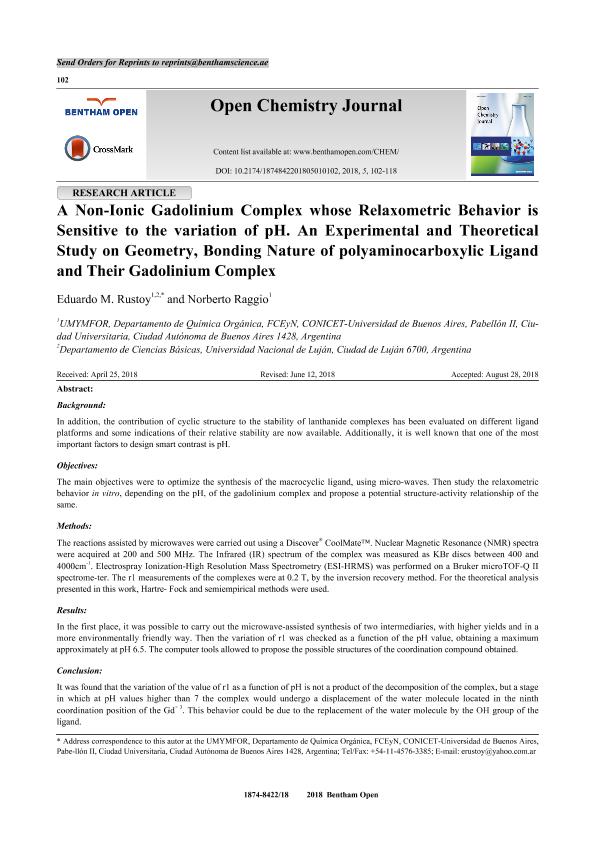Artículo
A non-ionic gadolinium complex whose relaxometric behavior is sensitive to the variation of pH: An experimental and theoretical study on geometry, bonding nature of polyaminocarboxylic ligand and their gadolinium complex
Fecha de publicación:
10/2018
Editorial:
Bentham Science Publishers
Revista:
Open Chemistry Journal
ISSN:
1874-8422
Idioma:
Inglés
Tipo de recurso:
Artículo publicado
Clasificación temática:
Resumen
Background: In addition, the contribution of cyclic structure to the stability of lanthanide complexes has been evaluated on different ligand platforms and some indications of their relative stability are now available. Additionally, it is well known that one of the most important factors to design smart contrast is pH. Objectives: The main objectives were to optimize the synthesis of the macrocyclic ligand, using micro-waves. Then study the relaxometric behavior in vitro, depending on the pH, of the gadolinium complex and propose a potential structure-activity relationship of the same. Methods: The reactions assisted by microwaves were carried out using a Discover® CoolMate™. Nuclear Magnetic Resonance (NMR) spectra were acquired at 200 and 500 MHz. The Infrared (IR) spectrum of the complex was measured as KBr discs between 400 and 4000cm-1. Electrospray Ionization-High Resolution Mass Spectrometry (ESI-HRMS) was performed on a Bruker microTOF-Q II spectrome-ter. The r1 measurements of the complexes were at 0.2 T, by the inversion recovery method. For the theoretical analysis presented in this work, Hartre- Fock and semiempirical methods were used. Results: In the first place, it was possible to carry out the microwave-assisted synthesis of two intermediaries, with higher yields and in a more environmentally friendly way. Then the variation of r1 was checked as a function of the pH value, obtaining a maximum approximately at pH 6.5. The computer tools allowed to propose the possible structures of the coordination compound obtained. Conclusion: It was found that the variation of the value of r1 as a function of pH is not a product of the decomposition of the complex, but a stage in which at pH values higher than 7 the complex would undergo a displacement of the water molecule located in the ninth coordination position of the Gd+ 3. This behavior could be due to the replacement of the water molecule by the OH group of the ligand.
Palabras clave:
Gadolinium
,
Magnetic resonance imaging
,
Macrocyclic ligand
,
MOPAC/Sparkle
Archivos asociados
Licencia
Identificadores
Colecciones
Articulos(SEDE CENTRAL)
Articulos de SEDE CENTRAL
Articulos de SEDE CENTRAL
Citación
Rustoy, Eduardo Miguel; Raggio, Norberto; A non-ionic gadolinium complex whose relaxometric behavior is sensitive to the variation of pH: An experimental and theoretical study on geometry, bonding nature of polyaminocarboxylic ligand and their gadolinium complex; Bentham Science Publishers; Open Chemistry Journal; 5; 1; 10-2018; 102-118
Compartir
Altmétricas




